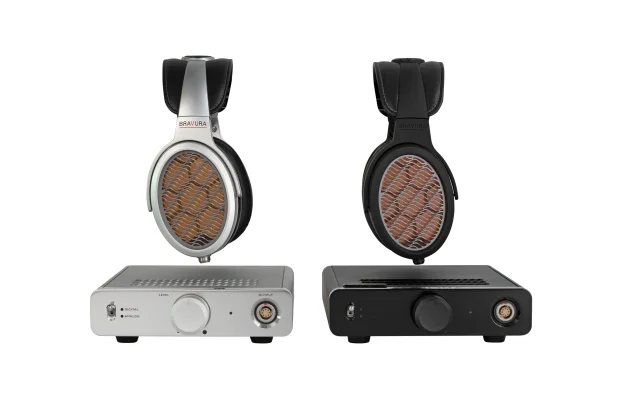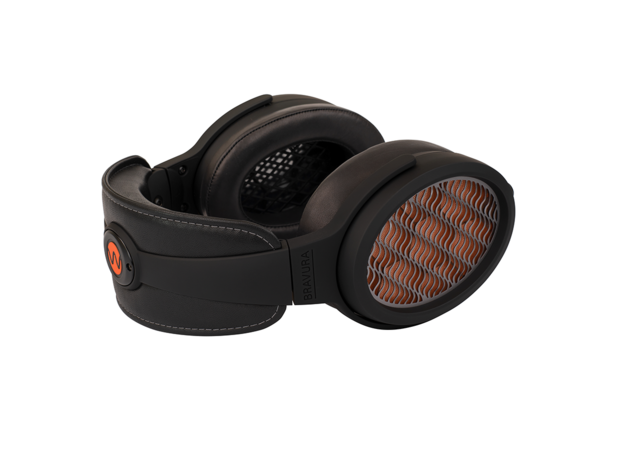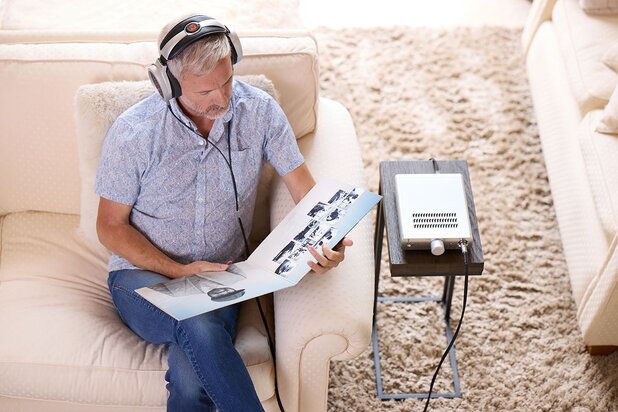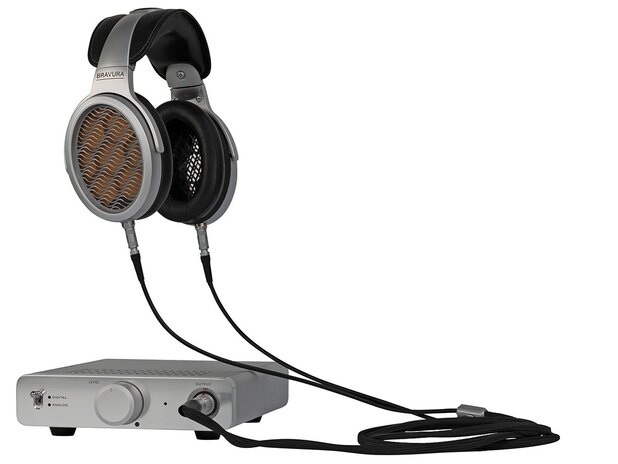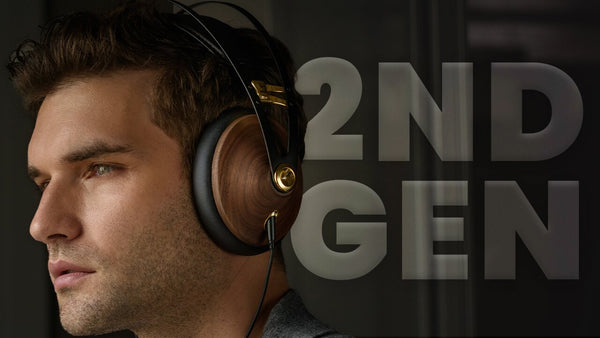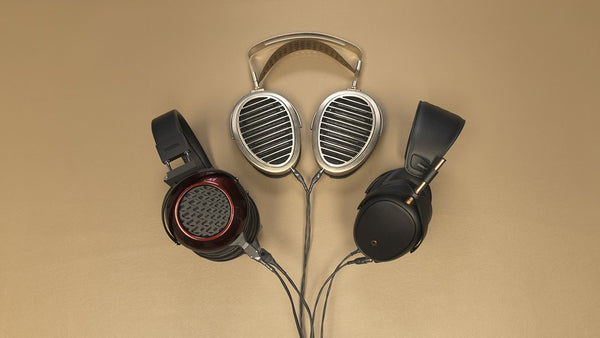Warwick Acoustics BRAVURA Headphone Review
Read Time: Approx. 16 min.

BRAVURA Electrostatic Headphone System is 'Designed to Amaze'
A few years ago, the British company Warwick Acoustics took their expertise with electrostatic driver technology and got into the audiophile headphone game with the Sonoma M1 (Model One) electrostatic headphone system. The Sonoma M1 is a complete system including headphones plus an energizing headphone amplifier and DAC. Now, Warwick Acoustics has released an update to the Sonoma M1 called the BRAVURA.
Three years in the making, the BRAVURA uses the same proprietary HPEL driver technology as the Sonoma M1, but with some updates. And the best result of those updates is that the BRAVURA can output more sound — it's on average 10-12dB louder across the frequency range — than the Sonoma M1. And because the BRAVURA is using the same amplifier as the Sonoma M1, this confirms that there are driver improvements within the BRAVURA headphones themselves. Other improvements to the BRAVURA, according to Warwick Acoustics, are a new "less clampy" headband and a new cable that corrects the "you touch it, you hear it" effect of the Sonoma M1 cable.
If you are familiar with electrostatic headphones, you know that they have special power requirements that necessitate the use of a high-voltage drive amplifier (also called an energizer, because it energizes or "excites" the driver). The good news is that the Bravura uses the same amplifier as the Sonoma M1, so if you own that, you can simply update the headphones. Otherwise, you'll need to purchase the Sonoma M1 amplifier to power the BRAVURA headphones.
BRAVURA (noun): From Italian, meaning "great technical skill and brilliance shown in a performance or activity."
Warwick Acoustics BRAVURA Headphones + Amplifier Review & Comparison

PROS
- Natural, transparent sound
- Good bass response and improved SPL
- Choice of silver or black
CONS
- Must purchase comparison Sonoma M1 amplifier (unless you already own it)
- Headphones still a bit "clampy"
Design
Available in silver or a special edition matte black, the BRAVURA headphones are eye-catching--plus they look and feel substantial and well-made. The black version, which I demoed, has silver grilles that give a peek to the copper mesh behind them that protects the drivers. The top of the headphone features a simple black "W" logo etched into a dark orange circle. The headband is much wider and thicker than the headband on the Sonoma M1. It's actually a version of the headband from Warwick's flagship APERIO headphone. The hand-stitched leather cushion is generously padded.
The headband itself is touted as being less "clampy" than the Sonoma M1. In my opinion, both headphones seem to have a rather substantial clamping force; I don't perceive less with the BRAVURA. I wouldn't say this is unpleasant, but it could be uncomfortable for some people. Headphone fit is subjective and depends on things like head shape and width and ear size. The ear cups are injected magnesium with handmade sheep's hair cushions.
The cable for the BRAVURA has been updated. According to Warwick, the Sonoma M1's cable system was prone to ‘touch it, you hear it’ effects. The BRAVURA comes with a new ultra-low-capacitance cable that is thicker than the Sonoma M1 cable. Now, electrostatic headphones require specialized cables. An electrostatic headphone does not present a normal load to any partnering amplifier. As a result, it is impossible to use just any cable to connect an amplifier to headphones. Whereas the Sonoma M1 cable is fabric until the splitter, where it switches to polyurethane, the BRAVURA cable is fabric all the way. I like that there's a prominent dark orange ring under the right side connector.
Warwick's criteria for the BRAVURA cable:
- Capacitance had to be minimized
- Mechanical noise pickup had to be minimized
- Signal purity had to be maximized
- The cable had to be thin, flexible, and lightweight
"We developed a bespoke ultra-low capacitance cable to guarantee optimal signal transfer between amplifier and headphone. Manufactured in collaboration with ATLAS and LEMO, the cable is strengthened with Kevlar between the inner cores, and uses high-precision self-latching LEMO connectors. A high quality woven Moplen outer braiding with soft feel and ultra-wear resistance ensures a luxury user experience."
–Warwick Acoustics
Sound
The BRAVURA has many sound attributes associated with electrostatic headphones. It's transparent, airy, and detailed with good transient response. The sound is very natural, with a little bit of warmth. The organic quality of the sound hooked me right away ... and yet, the BRAVURA doesn't sound exactly like an e-stat, which I expect to sound a bit analytical or bright. The BRAVURA is neither. The midrange is what captured my attention right away: It's got a lot of heft, with vocals right up front on most tracks. Treble, meanwhile, is nothing short of gorgeous, lending nice detail and airiness to the sound. Bass has a pleasing punch, and to my ears it's noticeably more impactful than on the Sonoma M1. Instrument separation is phenomenal. I had such a sense of different sounds and frequencies floating around my head.
I started out listening to a trio of songs that have been in my "drive to work" rotation: "Bitterblue," "Moonshadow," and "Peace Train" from Cat Stevens' Teaser and the Firecat. Right off the bat, I was deeply engaged with the guitar strumming on the first track. Electrostatic headphones have a way of making strings sound magical, and this was no exception. And then there was the passionate grit in Stevens' voice. The BRAVURA definitely seemed to put an emphasis on the midrange. I could hear some nice bells and tambourine in the background, too. On the more delicate "Moonshadow," Stevens' voice was front and center with everything else beautifully complementing it. The background vocals were really lovely here, too, cascading down around the rest of the music like a waterfall. Truth be told, this song has never been a favorite, but the BRAVURA made me like it more. Finally, on "Peace Train," I enjoyed the deep thump of the drums and bass guitar and the strumming of the acoustic guitar, the latter of which gave me pleasant chills across my back.
Switching to Pink Floyd (but not one of the typical albums I use in reviews), I cued up "Fearless" from the album Meddle. This track has a sort of "rise and fall" cadence that alternates between loud and quiet. The BRAVURA kept up nicely here, without my having to adjust the volume or strain to hear the softer parts. A really cool thing is that I heard something in the song that I had never noticed before: a small, higher-pitched sound borrowed from the song "Echoes" (on the same album). Why had I never noticed this before? Probably because I'd never listened on a headphone that excels with detail the way the BRAVURA does. Near the end, "Fearless" fades into a version of "You'll Never Walk Alone" from the Rodgers and Hammerstein musical Carousel. This particular version was allegedly recorded at a soccer game, with a crowd of voices belting it out in a sort of chant. This, again, gave me chills. I really felt that I was dropped down in the middle of the stadium and hearing the voices all around me.
Next, I listened to "Julius," a jazzy, uptempo number from Phish. Admittedly, the horns on this track can be "too much" for my ears on an analytical or treble-forward headphone. Listening with the BRAVURA, though, the highs were pleasant and non-screechy. I enjoyed the more midrange focus here, with Trey Anastasio's vocals being more prominent than I'm used to. Additionally, I found myself following the bassline more than I normally would. It was wonderfully tight and contained but added some nice low-end heft.
I rounded things out with "Beloved Wife" by Natalie Merchant. I've listened to this song on many headphones. There's a lot of bass boom in this recording, which can easily overpower the other elements in the song. On the BRAVURA, the bass felt more contained, with the gentle guitar strums and delicate piano notes holding their own. And Merchant's gut-wrenching vocal delivery here was right out front, as (in my opinion) it should be. Bravo to the BRAVURA!
I feel like the BRAVURA strikes the right balance between microdetails and low-end depth. There is more than enough detail to satisfy critical listeners, but the treble never overwhelms. There's also a nice amount of low-end presence to add solidity and interest to the most minimalistic tracks.

Bitterblue
By Cat Stevens
(Teaser and the Firecat)

Fearless
By Pink Floyd
(Meddle)

Julius
By Phish
(Hoist)
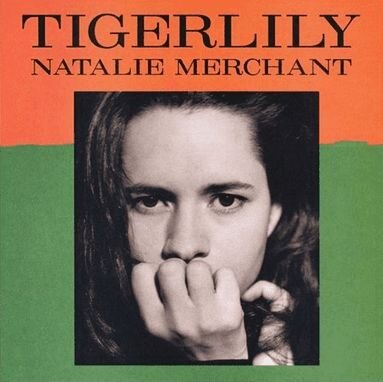
Beloved Wife
By Natalie Merchant
(Tigerlily)
Features
HPEL Driver Technology
Founded in 2002, Warwick Acoustics (previously known as Warwick Audio Technologies Inc.) spun off from work being done on electrostatic transducers (aka drivers) in the School of Engineering at the University of Warwick in England. Warwick Acoustics' claim to fame has been their award-winning HPEL driver technology. HPEL stands for High Precision Electrostatic Laminate.
In traditional electrostatic drivers (also called transducers), a thin diaphragm with a conductive coating is typically stretched between two metal grids with a positive charge, called stators. Adjusting the voltage on the grids, and the resulting change in the magnetic field, sets the foil in motion and thus generates sound. With the HPEL driver, there is only one stator. The second element is then a spacer, which is connected to a conductive metal grid. The foil itself is laminated with a metal film and in turn is bonded directly to the honeycomb separator. This is divided into different cells that are tuned to different frequencies and can work independently. For more stability, the construct is finally packed in a separate plastic cassette. HPEL technology offers a particularly large frequency range and at the same time removes the stator between the sound transducer and the ear.
For the BRAVURA, Warwick invested three years of HPEL development to refine their core patented technology to further improve upon all the benefits for which electrostatics are famous. The latest evolution of the single-ended HPEL uses a new stator design and more advanced materials resulting in ultra-low distortion, increased SPL, and a wider bandwidth. Each HPEL is handmade and individually matched.
Sonoma M1 Amplifier/DAC: Features & Technology
The BRAVURA headphones use the same amplifier/DAC as the Sonoma M1. The Sonoma M1 amplifier was previously available in silver only, but it's now available in black matte or silver matte. So if you're purchasing it now, you have your choice. The unit is compact but solidly constructed from machined aluminum, measuring about 2.2 x 7.5 x 11.4 inches (57x190x290mm). The top of the unit features three rows of vents (for heat dissipation) in the same 3-D wave pattern as the headphone grilles. The front of the unit has a toggle switch for digital and analog; a volume knob, and the headphone output. On the back, you've got your power switch, digital inputs (USB and coax S/PDIF), and two stereo analog inputs (one high-level via RCA jacks; one low-level via 3.5mm mini socket).


The Sonoma M1 DAC is an ESS 32-bit reference DAC. Two stereo DAC chips are used in a special mono mode to deliver a measured 129 dB signal-to-noise ratio (SNR). Each stereo DAC chip is operated in mono mode to provide a measured 129 dB signal-to-noise ratio.
The Sonoma M1 amplifier is a high-performance, single-ended, discrete FET Class-A amplifier with very low distortion and wide bandwidth which is optimally matched to the HPEL driver. The amplifier was designed and optimized to drive the inherent capacitive load of an electrostatic transducer, and the Class-A output stage is operated at a high bias level, and delivers a very high slew-rate. Operating at such high bias levels results in improved linearity. The drive signal has a maximum amplitude of 145 V (rms), which is superimposed on the 1350 V DC bias. Despite operating at low current levels, the high voltages in use translate to significant power (for a headphone amplifier) at the output of the amplifier. Consequently, high quality devices are used throughout which are designed to cope with the power levels.
The amplifier provides the following inputs:
- USB 2.0 (digital)
- Coaxial S/PDIF (digital)
- High-level RCA (x2) jacks (analog)
- Low-level 3.5mm stereo jack (analog)
The USB 2.0 input accepts all Hi-Res Audio formats up to 32-bit/384 kHz PCM and DSD via DoP (DSD64/DSD128), while the S/PDIF input accepts all PCM formats up to 24-bit/192 kHz. The high-level RCA inputs operate with a maximum input signal of 2.1 V (rms), while the low-level 3.5 mm jack accepts a maximum signal of 850 mV (rms).
Custom 64-Bit Fixed-Point Digital Signal Processing
The BRAVURA is designed to deliver the most natural and honest reproduction of original sound recordings. Therefore, Warwick Acoustics does only a subtle amount of DSP (Digital Signal Processing) with minimal effect to the frequency response curve. In order to obtain the desired response at the output of the headphones, they digitally process all signals using custom 64-bit double-precision fixed-point arithmetic. Fixed-point is known to be superior in the world of audio processing, and Warwick's 64-bit arithmetic exceeds even the performance of professional audio workstations. Taking further advantage of the incredible accuracy of the 64-bit DSP, Warwick Acoustics was able to implement within the amplifier a fully-digital interpolated volume control that outperforms all the pure-analog, stepped attenuators they evaluated. The benefits include:
- No loss in fidelity and no loss in dynamic range
- Perfect left/right channel matching
- No potentiometer/attenuator non-linearities at the end of range
- No noise issues like "zipper" noise, clicks/pops, etc.
AKM Premium ADC
All incoming analog signals must be converted to digital ahead of the DSP, and for this Warwick Acoustics uses a multi-channel 32-bit/384 kHz AKM Premium ADC to deliver a measured signal-to-noise ratio in excess of 120 dB.
Superior USB Data Cable
With gold-plated connectors and a silver-plated data path, the supplied USB cable, co-developed with Straight Wire, is the perfect connection between your digital music source and the Sonoma M1 system.
Custom Universal Voltage PSU
The custom-designed, universal voltage switch-mode power supply utilizes a fixed frequency design optimized for low noise within the audio bandwidth. To ensure a good connection with the amplifier unit, Warwick uses high-performance, locking DC power connectors. All audio circuitry within the amplifier is supplied by a secondary stage of ultra-low noise, high current linear regulation.
Comparisons
The HifiMan Shangri-La Jr. has a very crisp sound that borders on analytical, with highs that are quite pronounced. To me, it's the more "typical" sounding electrostatic headphone. The Dan Clark Audio VOCE was created with the intention of being a complement to the STAX SR-009 electrostatic headphone. The STAX has a brighter sound, whereas the VOCE has more relaxed treble. The bass has a bit of warmth. It has plenty of detail, but it's not the most heavy-hitting. I would give the highest comfort score to the VOCE and the looks score to the BRAVURA. As far as sound, that's more subjective. For a smoother sound, you could opt for the BRAVURA or the VOCE. But for a smoother sound with more impactful bass, the BRAVURA is the way to go.
Here's something to consider if, for example, you're deciding between the BRAVURA and the VOCE. Because the BRAVURA has a higher bias voltage (1350Vdc), you must use it with an appropriately matched amplifier, i.e. the Sonoma M1 amplifier. Depending whether you choose silver or black, this combo will run you $5,995 or $6,795. The VOCE has a lower bias voltage and can be used with any 860 pro bias amplifier, such as the HiFiMan Shangri-La Jr. That combo will run you over $8,000.
Verdict
The BRAVURA is a complete electrostatic headphone system that shows off significant upgrades over its predecessor, the Sonoma M1. The Sonoma M1 was absolutely a great "first effort" for Warwick Acoustics, but the BRAVURA is a better headphone all around: looks, feel, and sound. It's a more substantial feeling and more comfortable headphone, even if it does retain some of the excess clamping force of the Sonoma M1. It's got a more robust bass response and increased resolution. Perhaps its biggest achievement is its enhanced SPL; it produces more volume with less effort. I like that the amplifier is relatively compact, leaving room on your desk or table for plenty of other things. If you listen to a lot of classical, jazz, acoustic, or vocal music, and you enjoy a detailed sound that is a little more relaxed in the treble than your average electrostatic headphone, the BRAVURA is a worthy contender.
Featured Products
Related Videos
Warwick Acoustics Bravura Headphones + Amplifier Review & Comparison
Electrostatic Headphones Explained
Warwick Acoustics APERIO Headphone System Review
What's in the Box
Specifications
BRAVURA Headphones:
- Type: Open-back headphones; circumaural type
- Drivers: HPEL, single-ended electrostatic
- Effective driver area: 3570mm2
- Transducer capacitance: 105pF
- Bias voltage: 1350Vdc
- THD: 0.1% @ 1kHz / 100dB SPL
- Moving mass (for dynamic range): > 0.2g
- Frequency response: 10Hz - 60kHz
- Cable: Ultra-low capacitance, High-precision cable, 2m length
- Weight: 403g (14.2oz)
Sonoma M1 DAC/Headphone Amplifier:
- Type: Class A solid-state electrostatic headphone energizer with build-in DAC, ADC, and DSP functions
- Inputs: One USB digital input, one coaxial S/PDIF digital input, two stereo analog inputs (one high-level via RCA jacks, one low-level via 3.5mm mini socket)
- Outputs: One electrostatic headphone/bias voltage output jack
- DAC: Dual mono, 32-bit/384 kHz ESS DACs with balanced outputs
- Digital Audio Formats Supported
- USB: All PCM inputs up to 32-bit/384 kHz and DSD via DoP (DSD64/DSD128)
- Coaxial S/PDIF: All PCM inputs up to 24-bit/192kHz
- Device Drivers: An XMOS device driver is required when the Bravura system is used in Windows environments
- Frequency response: Bandwidth > 65kHz
- Distortion + Noise: <0.05%
- Dimensions (HxWxD): 57x190x290mm
- Weight: 2.45kg




